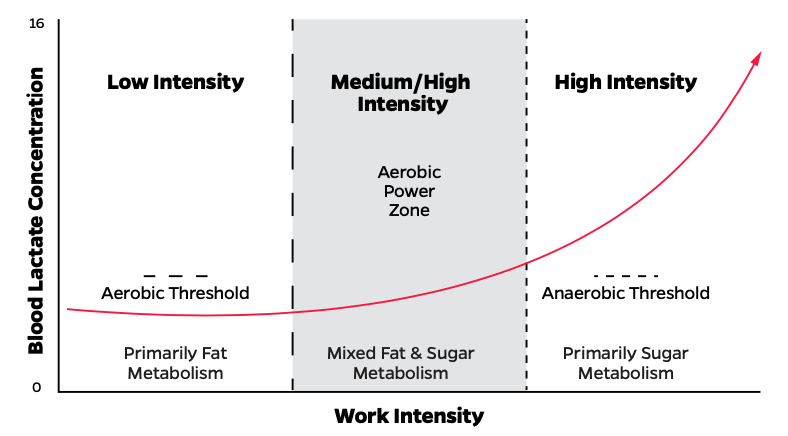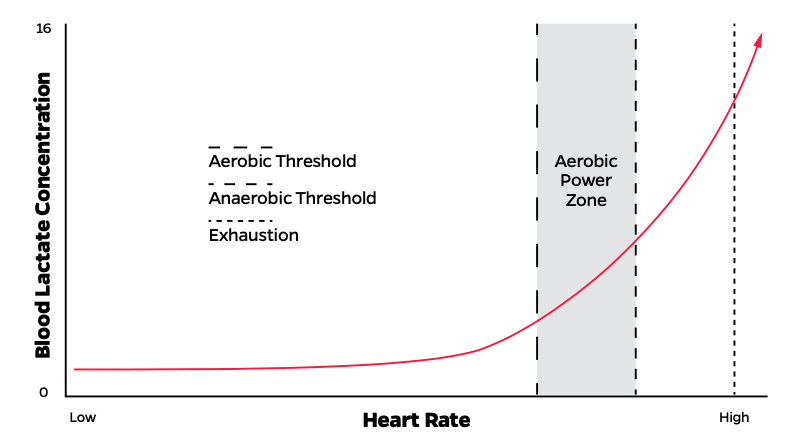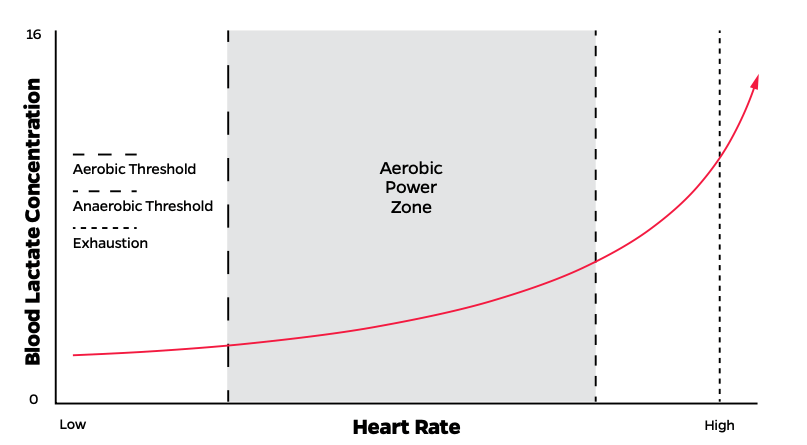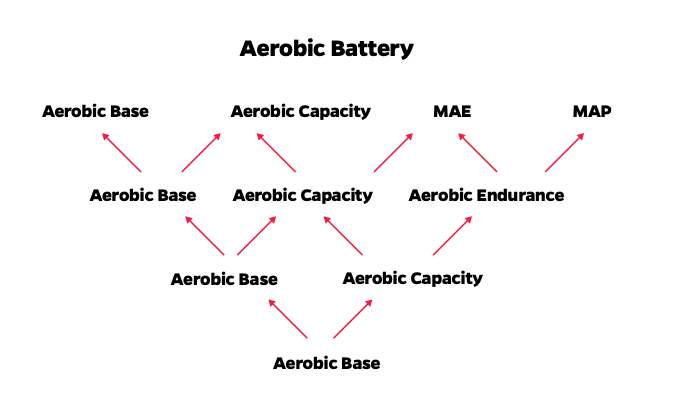The anaerobic threshold is the lowest intensity of exercise at which the production of lactate exceeds the body’s ability to utilize lactate as fuel in aerobic metabolism. Once you go above this intensity, blood lactate levels begin to rise.
Table of Contents
The greater the intensity of exercise above the anaerobic threshold, the greater the rise in blood lactate as the production of lactate exceeds its rate of removal. Exercising above the anaerobic threshold can only be sustained for a few minutes at a time before fatigues sets in, causing you to slow down.
In simplistic terms, this is the maximum amount of work you can sustain for a long duration. Your pace at anaerobic threshold is the greatest predictor of endurance performance because it is the rate at which the body can sustainably produce energy.
It is the most trained threshold in fitness and sports, and is often prioritized above its little brother, the aerobic threshold. In this article, you will learn about the anaerobic threshold, how to maximize your anaerobic threshold, and why it should be the last element of building a robust cardiovascular engine.
Prior to reading this article, if you haven’t done so already, I highly recommend reading “The Beginners Guide to Cardio: The Ultimate Guide” and “Aerobic Threshold: The Ultimate Guide.” They are the first articles in this series, and they set the scene and precedence for this piece.
Cardiovascular training and, in particular, training the anaerobic system is one of the most poorly understood concepts in fitness. It is widely believed that anything that raises your heart can be deemed to be cardio.
This couldn’t be further from the truth. Just like strength training, you need to obey the laws of physiology and work in conjunction with the CNS (Central Nervous System), and there’s a system and process to maximally developing the cardiovascular system.
That process begins by maximally developing your aerobic threshold.
Having read our previous articles, “The Beginners Guide to Cardio” and “The Aerobic Threshold,” you know that to truly maximize your cardiovascular capacity, you must first maximize your aerobic threshold.
I’ll remind you of our model of cardiovascular development:
“If you don’t maximally develop your aerobic energy system first and have sufficient levels of strength, you will never truly maximize your anaerobic threshold.”
Today’s article is all about the anaerobic threshold. What it is, why you need to train it, and more importantly, how you can maximize your anaerobic threshold for improved cardiovascular endurance. Let’s dive in.
What Is Your Anaerobic Threshold?
The anaerobic threshold is the lowest intensity of exercise at which the production of lactate exceeds the body’s ability to utilize lactate as fuel in aerobic metabolism. Once you go above this intensity, blood lactate levels begin to rise.
The greater the intensity of exercise above the anaerobic threshold, the greater the rise in blood lactate as the production of lactate exceeds its rate of removal. Exercising above the anaerobic threshold can only be sustained for a few minutes at a time before fatigues sets in, causing you to slow down.
In simplistic terms, this is the maximum amount of work you can sustain for a long duration. Your pace at anaerobic threshold is the greatest predictor of endurance performance because it is the rate at which the body can sustainably produce energy.
Every athlete knows this point. When you cross it, you know you can only hold this pace for a short time before you have to dramatically stop. That’s your anaerobic threshold.
It’s important to understand the role of lactic acid, which is so often seen as the cause of poor cardiovascular capacity. Lactic acid only appears in the body when the body can no longer work aerobically, and lactic acid begins to accumulate through anaerobic glycolysis.
The two golden rules of developing the cardiovascular system are this:
- Reduce the production of lactate by having a higher aerobic threshold.
- Increase the rate of lactate removal from the working muscles by having a fully functioning anaerobic system.
Step 1 is all about maximizing your aerobic threshold. Step 2 is about maximizing your anaerobic threshold. Both need to be trained very differently, but both are key to maximizing the cardiovascular system.
The image below illustrates where the anaerobic threshold sits and how blood lactate concentration starts to dramatically increase as the workout intensity increases. It also illustrates the primary fuel sources at each level.

As you can see in the image, there are essentially three zones of training: below the aerobic threshold, a mixture of both aerobic and anaerobic zones, and the zone above the anaerobic threshold.
One of the biggest problems we see with everyday athletes, of all abilities and ages, is that they don’t spend time developing either aerobic or anaerobic threshold specifically. Instead, they spend the vast majority of their time training in what we call “the black hole of death,” that middle zone of nothing. The middle zone that uses both glucose and fat for fuel.
The secret of the world’s elite endurance athletes is to close the gap significantly between the aerobic threshold and the anaerobic threshold. Most elite endurance athletes have less than a 10% difference between the two. This means they can perform faster, for longer, and more frequently as they work below their aerobic threshold, using their fat stores as their primary fuel source.
The image below illustrates an example of an advanced endurance athlete with a high aerobic base. Notice how they can work out harder for longer before blood lactate starts to accumulate. Their middle zone of death is much smaller, and therefore, they spend less time using glucose (sugars) for energy and more time using fat.

On the flip side, the following picture shows somebody who suffers from ADS (Aerobic Deficiency Syndrome). They have a very poor aerobic threshold and their middle zone of death is considerably larger. This means they will tire much faster than the advanced athlete above.

I would argue that the vast majority of the world’s population suffers from Aerobic Deficiency Syndrome. We are wired to believe that we should work out harder for longer, just like the sizzle reels of elite athlete training videos, and so we often miss the hard work, dedication, and patience it requires to really maximize your true athletic potential.
With that logic in mind, I would argue even more strongly that over 90% of the world’s population has no right to train the anaerobic threshold. As you will soon discover, in the Strength Matters Hierarchy of Athletic Development, there is a logic and process to truly maximize your cardiovascular potential.
Anaerobic threshold development is the last component.
What Is the Difference Between Anaerobic Threshold and Lactate Threshold?
Anaerobic threshold and lactate threshold can be described as the same, but different. They both represent the maximum pace sustainable for an extended duration. We choose to use the term anaerobic threshold as it is in keeping with our ideas of aerobic threshold development, and it keeps the language consistent between coaches and athletes.
To everyone except sport scientists, these terms are interchangeable. But the key difference is that lactate threshold is determined by measuring the amount of lactate in the athlete’s blood during a lab test, rather than measuring oxygen consumed for the anaerobic threshold.
Either way, when the lactate volume in the blood reaches 4mmol/L (“millimoles per litre”), the athlete is assumed to be at lactate or anaerobic threshold.
Why Is Your Anaerobic Threshold Important?
From a cardiovascular and endurance performance standpoint, the ability to make use of lactate in the muscles and utilize it as fuel is one of the most important training adaptations you can make as an athlete. This is why having a strong, robust anaerobic system is important to maximizing your cardiovascular potential.
Once you have maximized your aerobic threshold, which focuses on reducing the rate at which lactate is produced, you can then focus on improving the body’s ability to remove it.
The best way to view your cardiovascular system is to think of it as a vacuum, which sucks up all the lactate. The greater the aerobic threshold, the bigger the vacuum. The bigger the capacity of the vacuum, the more the anaerobic system can contribute to the overall energy production within the body.
In even simpler terms:
- The greater the aerobic threshold, the bigger the vacuum
- The more robust and trained the anaerobic system is, the MORE powerful the vacuum becomes, thus sucking up lactate at a much faster rate, allowing you to perform faster, for longer.
This is why you can never fully maximize your cardiovascular potential, no matter how high the intensity of the exercise you do, if you don’t fully develop your aerobic threshold first. Your vacuum simply isn’t big enough to hold all the lactate the body produces. It’s like having a V8 engine inside a smart car.
The key to maximal cardiovascular development is combining both aerobic threshold development and anaerobic threshold development.
This is what makes this type of training an art form. It’s more than just science. It depends on each individual athlete or person. Increasing the aerobic threshold requires a high volume of low intensity exercise, whereas improving the anaerobic threshold requires high intensity exercise.
But the key takeaway is this: you need far less anaerobic threshold training than you think. We suggest for everyday athletes over thirty, 90% of your annual training volume needs to be aerobic threshold training based in nature.
That’s right, just 10% of your annual training plan needs to be anaerobic in nature to maximize your cardiovascular potential.
How to Test Your Anaerobic Threshold
Similar to testing your aerobic threshold, to test your anaerobic threshold properly, you need the help of scientists and a laboratory. Anaerobic threshold testing involves 3-minute exercise stages that start easy but gradually rise to a higher intensity level, getting harder as you go. It can be done on a bike or on a treadmill, depending on your sport preference.
Heart rate and blood lactate (from a finger or ear prick) are measured at the end of each 3-minute stage, with the test lasting approximately 30 minutes. The test identifies the highest intensity you can maintain for at least 30 minutes and correlates this back to your heart rate based on blood lactate levels.
We only recommend the laboratory method for elite athletes, where the 1% differences will make all the difference. For the rest of us humans, if you’re interested in recording your current anaerobic threshold, here’s our do-it-yourself method.
**Important. We only prescribe anaerobic threshold testing for athletes who have a strong and robust aerobic system, can move well, and have pre-requisite strength levels. (Outlined below.)
The Uphill Run Test
Ensure that you have warmed up thoroughly prior to testing. Find a moderate hill that you can run up for thirty unobstructed minutes.
Use a heart rate monitor to start recording your heart rate as soon as you begin the test. Run at a maximal, but sustainable pace, for the full 30-minutes.
Try and maintain the same pace throughout the test. At the end of the 30-minutes, stop your heart rate monitor.
Your average heart rate will roughly (as it’s not perfect) indicate your anaerobic threshold level.
Have You Earned the Right to Train Your Anaerobic Threshold?
I’ve said this before, and I’ll say it again:
“If you don’t maximally develop your aerobic energy system first and have sufficient levels of strength, you will never truly maximize your anaerobic threshold.”
But what constitutes enough strength and a robust aerobic energy system? To elicit the correct dose response from anaerobic training, you need to dig deep into your central nervous system. This only comes with significant pre-requisite strength and aerobic capacity.
Here are our minimum strength standards that must be met prior to training the anaerobic threshold:
Women
- 1.25 x bodyweight deadlift x 5 reps
- Bodyweight back squat x 5 reps
- 3 x pull-ups
- 3 x dips
- 75% bodyweight farmers carry – 90 seconds
Men
- 1.5 x bodyweight deadlift x 5 reps
- Bodyweight back squat x 5 reps
- 5 x pull-ups
- 5 x dips
- 75% bodyweight farmers carry – 90 seconds
In addition to these strength standards, everyday athletes must demonstrate a strong aerobic threshold. To determine this, our go-to test follows.
Men/Women
- Can you run 10km in under 60 minutes with your heart rate below MAF (180 – Age) at all times?
You simply have to earn the right to train anaerobic threshold. If you can’t adhere to these baseline standards, we strongly believe that anaerobic threshold training is not for you.
Can you now see why we believe 90% of the world’s population shouldn’t be doing anaerobic threshold work?
Anaerobic threshold work is for advanced athletes. Not beginners. It’s why anaerobic capacity is a layer three component on our hierarchy of athletic development for good reason.
Earn the right to truly maximize your cardiovascular potential.
How to Train to Maximize Your Anaerobic Threshold
Before I talk to you about how to train anaerobic threshold, I want to introduce you to the Aerobic Tree, our model for developing aerobic capacity. If you are a complete novice to cardiovascular training, this model requires years and years and years of work before you get anywhere near anaerobic threshold training.
I want to highlight the fact that there is much work ahead of you before you earn the right to train anaerobically, in our humble opinion. Yet, many people skip nearly all of this foundational work.

At the base of the tree, you have your aerobic base. This is as simple as walking 10,000 steps a day. As you climb the tree, you add layers to your development. The next is aerobic capacity – the ability to do continuous exercise for at least 60 minutes.
Once we have the base and can achieve 60-minutes of continuous work, we want to become as efficient as possible at completing these 60-minute pieces. It may be even longer.
Then, and only once we become extremely proficient in these 60-minute pieces, we can climb to the top of the tree and perform MAE (Maximal Aerobic Endurance), the ability to extend out to hours and hours of work, and MAP (Maximal Aerobic Power) work.
MAP is the sexy, fun work in aerobic capacity. These are aerobic threshold and power intervals that get faster and faster in nature. This isn’t something you can jump into straight away.
You need base work, basic aerobic capacity, and aerobic endurance in place first so that you can recover quickly to perform each working set.
Aerobic does not mean slow in nature, which is what most people think. Elite marathoners run sub 5-minute miles for 26.1 miles straight. There aren’t many people who can run one mile at that pace, let alone 26.1.
Marathon runners may not run as fast as 100m sprinters, but they still run fast comparatively. It’s something to think about before you dismiss aerobic work.
How Do I Increase My Anaerobic Threshold?
By now you’ve earned the right to train your anaerobic threshold. You have the pre-requisite strength levels, and you’ve progressed all the way through the aerobic tree.
Here are the key concepts to remember as we progress:
- Aerobic Capacity: You train from Endurance to Power
- Anaerobic Capacity: You train from Power to Endurance
The basic principles of anaerobic threshold training are:
- Train intervals to exhaustion
- Rest completely
- Repeat
There is one caveat: all intervals must be identical in nature. This means that what you do is repeatable and sustainable in nature until it is not. It is when these intervals are no longer sustainable that you either stop for the day or in the next session, you progress your workload.
This differs from aerobic power intervals as they are not designed to train endurance. The anaerobic system needs to be fully restored for each interval so that you can train to the same maximum intensity.
Work periods tend to be short, sometimes as little as 8 seconds, separated by long recovery times. If the rest period is too short, the workout will shift to endurance training. The energy system you are training needs to fully recover to elicit the correct dose response.
As a general rule of thumb, our resting protocols tend to be around 10:1 (rest ten times the amount of work that you put in).
How to Improve Anaerobic Endurance
Anaerobic and endurance. These two words simply shouldn’t go together. It’s a complete misnomer. How can anaerobic work, which is unsustainable in nature, be considered endurance? Well, they do. There’s no easy way to say it, but this type of training is hard. Very hard. It hurts. It’s the “#ShittyShitShit of training,” as my friend James Fitzgerald says.
Improving your anaerobic threshold requires maximum training at the maximum intensity, and then extending the time at which you perform it over a longer time. For example, progressing 10-second sprints for ten sets (identical in nature), to 14 seconds sprints for ten sets (identical in nature).
Unlike aerobic threshold work, anaerobic training requires us to produce as much lactate as possible and to maintain that high level for as long as possible before giving ample rest to allow the body to remove the lactate. This is how we train the body to get better at removing lactate from the body. It’s exhausting work, and it is why you need years and years of training behind you before even attempting this type of work.
More importantly, if you have earned the right to train like this, anaerobic threshold work should only make up 10–15% of your annual training volume. You need far, far less of this, and far, far more of aerobic threshold work than you think.
Anaerobic Threshold Workout: Example
Warm-up appropriately. Ideally, jog one mile at a very low intensity and perform necessary mobility work.
- Find a hill, the steeper the better.
- Set a timer with a ten-second countdown, with a
- Perform 1 x hill sprint, at maximal intensity for 10 seconds.
- Make a note of the finishing point.
- Rest 2
- Repeat until you can no longer hit the same distance in 10 seconds.
- Continue until you can perform a maximum of ten sets
- Next session, if all ten sets are reached, increase by 2 seconds. Repeat the process.
**Important. If you cannot hit the same distance during any of the sets (e.g., set 5 or 6), you are finished for the day. Do not progress or push further.
This will no longer be anaerobic threshold work but will become endurance work. Each set has to be exactly the same for you to continue.
Closing Thoughts
Training the anaerobic threshold is one of the most misunderstood aspects of training the cardiovascular system. It is fashionable to train, as popularized by the world of HIIT (High-Intensity Interval Training).
However, as you have now learned, it takes years and years of work and dedication to actually earn the right to train the anaerobic system if you are truly looking to maximize your true athletic potential.
A strong aerobic base and pre-requisite levels of strength are paramount before even attempting this type of training.
Most of the world’s population arguably suffer from Aerobic Deficiency Syndrome due to poor choices of cardiovascular training or a complete lack of training awareness and ability. Most everyday athletes need to spend time developing these systems, but not the anaerobic system.
Remember, if you don’t maximally develop your aerobic energy system first and have sufficient levels of strength, you will never truly maximize your anaerobic threshold.
The key to training the anaerobic threshold is less volume, higher intensity, and progression from power to endurance. There are no shortcuts, and there is no easy way out.
Either way, you have to decide whether this type of training is right for you for the sake of your own health and athletic performance.
Here’s to a more robust cardiovascular system and better anaerobic threshold.
Further Reading
- What Is The Aerobic Threshold?
- The Aerobic Energy System.
- The Anaerobic Alactic Energy System.
- The Anaerobic Lactic Energy System
FAQ
What Is the Anaerobic Threshold?
The anaerobic threshold, also known as the lactate threshold, is the exercise intensity at which lactic acid starts to accumulate in the blood at a faster rate than it can be removed. This is usually caused by an increased reliance on anaerobic metabolism, which produces lactate as a byproduct. This threshold is often used as a marker for the switch from predominantly aerobic to anaerobic exercise.
Why Is the Anaerobic Threshold Important?
The anaerobic threshold is critical in determining a person’s endurance capability. It is often used to set training zones and intensities for endurance athletes. The higher an individual’s anaerobic threshold, the more intense they can exercise before fatigue sets in, improving their performance in endurance sports.
How Can You Improve Your Anaerobic Threshold?
Training at or slightly above your anaerobic threshold, often called threshold training, can help increase your anaerobic threshold. This type of training stresses your body to adapt to the accumulation of lactate, teaching it to clear lactate more efficiently and utilize it as a fuel source, thereby delaying the onset of fatigue. Some common forms of threshold training include tempo runs, interval training, and high-intensity interval training (HIIT).
What Is the Difference Between the Anaerobic Threshold and Lactate Threshold?
While both terms are often used interchangeably, they describe slightly different physiological occurrences. The anaerobic threshold is when the body’s energy demand outpaces the aerobic system’s capacity, leading to increased reliance on anaerobic metabolism. The lactate threshold, on the other hand, is the specific point at which blood lactate concentration starts to increase rapidly. However, in practice, they both typically occur at a similar exercise intensity and reflect a shift towards anaerobic metabolism.
What Is the Anaerobic Threshold and How Can It Be Determined?
The anaerobic threshold (AT) is the point during intense exercise where your body starts to produce lactic acid at a faster rate than it can be removed, leading to muscle fatigue. It can be determined through specific tests like graded exercise tests or by identifying the exercise intensity at which lactate begins to accumulate in the blood.
What Is Aerobic or Anaerobic Threshold?
The anaerobic threshold refers to the exercise intensity at which lactic acid starts to accumulate in the bloodstream. On the other hand, the aerobic threshold is the point at which the body switches from primarily using aerobic metabolism to anaerobic metabolism. Both are critical in understanding exercise performance and endurance.
What Is the Benefit of Anaerobic Threshold?
Understanding your anaerobic threshold is beneficial because it indicates your level of endurance and the intensity at which you can exercise before lactic acid rapidly accumulates. Training at or near the AT can improve endurance performance and increase the threshold itself, allowing for longer bouts of high-intensity activity.

